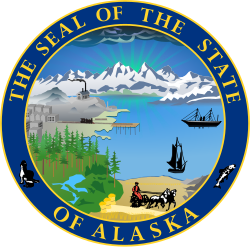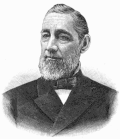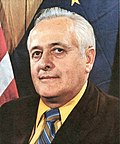List of governors of Alaska
From Wikipedia, the free encyclopedia
The governor of Alaska (Iñupiaq: Alaaskam kavanaa) is the head of government of Alaska. The governor is the chief executive of the state and is the holder of the highest office in the executive branch of the government as well as being the commander in chief of the Alaska's state forces.
| Governor of Alaska | |
|---|---|
| Alaaskam Kavanaa | |
 | |
| Government of Alaska | |
| Residence | Alaska Governor's Mansion |
| Term length | Four years, renewable once consecutively |
| Inaugural holder | William A. Egan |
| Formation | January 3, 1959 |
| Succession | Line of succession |
| Deputy | Lieutenant Governor of Alaska |
| Salary | $145,000 (2022)[1] |
| Website | gov |
Twelve people have served as governor of the State of Alaska over 14 distinct terms, though Alaska had over 30 civilian and military governors during its long history as a United States territory. Only two governors, William A. Egan and Bill Walker, were born in Alaska. Two people, Egan and Wally Hickel, have been elected to multiple non-consecutive terms as governor. Hickel is also noted for a rare third party win in American politics, having been elected to a term in 1990 representing the Alaskan Independence Party. The longest-serving governor of the state was Egan, who was elected three times and served nearly 12 years. The longest-serving territorial governor was Ernest Gruening, who served over 13 years.
The current governor is Republican Mike Dunleavy, who took office on December 3, 2018.
Governors before statehood
Summarize
Perspective
Alaska was purchased by the United States from the Russian Empire in 1867, with formal transfer occurring on October 18, 1867,[2] which is now celebrated as Alaska Day. Before then, it was known as Russian America or Russian Alaska, controlled by the governors and general managers of the Russian-American Company.
Commanders of the Department of Alaska
The vast region was initially designated the Department of Alaska, under the jurisdiction of the Department of War and administered by Army officers until 1877, when the Army was withdrawn from Alaska. The Department of the Treasury then took control, with the Collector of Customs as the highest ranking federal official in the territory. In 1879, the Navy was given jurisdiction over the department.[3]
Some believe the first American administrator of Alaska was Polish immigrant Włodzimierz Krzyżanowski. However, the Anchorage Daily News was unable to find any conclusive information to support this claim.[4]
| No. | Commander | Position | Term in office | |
|---|---|---|---|---|
| 1 |  |
Jefferson C. Davis (1828–1879) |
Army Colonel |
October 18, 1867 – August 31, 1870 |
| 2 |  |
George K. Brady (1838–1899) |
Army Captain |
September 1, 1870 – September 22, 1870 |
| 3 |  |
John C. Tidball (1825–1906) |
Army Major |
September 23, 1870 – September 19, 1871 |
| 4 |  |
Harvey A. Allen (1818–1882) |
Army Major |
September 20, 1871 – January 3, 1873 |
| 5 |  |
Joseph Stewart (1822–1904) |
Army Major |
January 4, 1873 – April 20, 1874 |
| 6 |  |
George B. Rodney Jr. (1842–1927) |
Army Captain |
April 21, 1874 – August 16, 1874 |
| 7 |  |
Joseph B. Campbell (d. 1891) |
Army Captain |
August 17, 1874 – June 14, 1876 |
| 8 |  |
John Mendenhall (1829–1892) |
Army Major |
June 15, 1876 – March 4, 1877 |
| 9 |  |
Arthur Morris (1843–1892) |
Army Captain |
March 5, 1877 – June 14, 1877 |
| 10 |  |
Montgomery P. Berry (1828–1898) |
Collector of Customs |
June 14, 1877 – August 13, 1877 |
| 11 |  |
Henry Charles DeAhna (d. 1891) |
Collector of Customs |
August 14, 1877 – March 26, 1878 |
| 12 |  |
M. D. Ball (1835–1887) |
Collector of Customs |
March 27, 1878 – June 13, 1879 |
| 13 |  |
Lester A. Beardslee (1836–1903) |
Navy Captain |
June 14, 1879 – September 12, 1880 |
| 14 |  |
Henry Glass (1844–1908) |
Navy Commander |
September 13, 1880 – August 9, 1881 |
| 15 |  |
Edward P. Lull (1836–1887) |
Navy Commander |
August 10, 1881 – October 18, 1881 |
| 16 |  |
Henry Glass (1844–1908) |
Navy Commander |
October 19, 1881 – March 12, 1882 |
| 17 |  |
Frederick Pearson (1842–1890) |
Navy Commander |
March 13, 1882 – October 3, 1882 |
| 18 |  |
Edgar C. Merriman (1840–1894) |
Navy Commander |
October 4, 1882 – September 13, 1883 |
| 19 |  |
Joseph Coghlan (1844–1908) |
Navy Commander |
September 15, 1883 – September 13, 1884 |
| 20 |  |
Henry E. Nichols (1842–1899) |
Navy Lieutenant commander |
September 14, 1884 – September 15, 1884 |
Governors of the District of Alaska
On May 17, 1884, the Department of Alaska was redesignated the District of Alaska, an incorporated but unorganized territory with a civil government.[5] The governor was appointed by the president of the United States.
| No. | Governor | Term in office[a] | Appointed by | |
|---|---|---|---|---|
| 1 |  |
John Henry Kinkead (1826–1904) [6] |
July 4, 1884[b] – May 8, 1885 (successor appointed) |
Chester A. Arthur |
| 2 |  |
Alfred P. Swineford (1836–1909) [10] |
May 8, 1885[c] – April 13, 1889 (resigned)[d] |
Grover Cleveland |
| 3 |  |
Lyman Enos Knapp (1837–1904) [17] |
April 13, 1889[e] – June 28, 1893 (successor appointed)[f] |
Benjamin Harrison |
| 4 |  |
James Sheakley (1829–1917) [21] |
June 28, 1893[g] – July 15, 1897 (resigned)[h] |
Grover Cleveland |
| 5 |  |
John Green Brady (1848–1918) [25] |
June 19, 1897[i] – March 21, 1906 (resigned)[j] |
William McKinley |
| Theodore Roosevelt | ||||
| 6 |  |
Wilford Bacon Hoggatt (1865–1938) [31] |
March 21, 1906[k] – October 1, 1909 (resigned)[l] |
Theodore Roosevelt |
| 7 |  |
Walter Eli Clark (1869–1950) [36] |
May 20, 1909[m] – August 24, 1912 (became territorial governor) |
William Howard Taft |
Governors of the Territory of Alaska
The District of Alaska was organized into Alaska Territory on August 24, 1912.[40] Governors continued to be appointed by the president of the United States.
| No. | Governor | Term in office[a] | Appointed by | |
|---|---|---|---|---|
| 1 |  |
Walter Eli Clark (1869–1950) [36] |
August 24, 1912 – May 1, 1913 (resigned)[n] |
William Howard Taft |
| 2 |  |
John Franklin Alexander Strong (1856–1929) [42] |
May 1, 1913[o] – April 12, 1918 (successor appointed)[p] |
Woodrow Wilson |
| 3 |  |
Thomas Riggs Jr. (1873–1945) [48] |
April 12, 1918[q] – June 13, 1921 (resigned)[r] |
Woodrow Wilson |
| 4 |  |
Scott Cordelle Bone (1860–1936) [52] |
June 13, 1921[s] – February 18, 1925 (successor appointed) |
Warren G. Harding |
| 5 |  |
George Alexander Parks (1883–1984) [56] |
February 18, 1925[t] – March 30, 1933 (successor appointed) |
Calvin Coolidge |
| 6 |  |
John Weir Troy (1868–1942) [60] |
March 30, 1933[u] – December 5, 1939 (resigned)[v] |
Franklin D. Roosevelt |
| 7 |  |
Ernest Gruening[w] (1887–1974) [67] |
September 2, 1939[x] – March 16, 1953 (successor appointed) |
Franklin D. Roosevelt |
| Harry S. Truman | ||||
| 8 |  |
B. Frank Heintzleman (1888–1965) [74] |
March 16, 1953[y] – January 3, 1957 (resigned)[z] |
Dwight D. Eisenhower |
| 9 |  |
Mike Stepovich (1919–2014) [81] |
May 16, 1957[aa] – August 9, 1958 (resigned)[ab] |
Dwight D. Eisenhower |
Governors of the State of Alaska
Summarize
Perspective
Alaska was admitted to the Union on January 3, 1959.
The state constitution provides for the election of a governor and lieutenant governor every four years on the same ticket, with their terms commencing on the first Monday in the December following the election. Governors are allowed to succeed themselves once, having to wait four years after their second term in a row before being allowed to run again. Should the office of governor become vacant, the lieutenant governor assumes the office of governor. The original constitution of 1956 created the office of secretary of state, which was functionally identical to a lieutenant governor, and was renamed to "lieutenant governor" in 1970.[87]
| No. | Governor | Term in office | Party | Election | Lt. Governor[ac][ad] | |||
|---|---|---|---|---|---|---|---|---|
| 1 |  |
William A. Egan (1914–1984) [88][89] |
January 3, 1959[90] – December 5, 1966 (lost election)[ae] |
Democratic[92] | 1958 | Hugh Wade | ||
| 1962 | ||||||||
| 2 |  |
Wally Hickel (1919–2010) [93][94] |
December 5, 1966[95] – January 24, 1969 (resigned)[af] |
Republican[92] | 1966 | Keith Harvey Miller | ||
| 3 |  |
Keith Harvey Miller (1925–2019) [96][97] |
January 24, 1969[98] – December 7, 1970 (lost election) |
Republican[92] | Succeeded from secretary of state |
Robert W. Ward | ||
| 1 |  |
William A. Egan (1914–1984) [88][89] |
December 7, 1970[99] – December 2, 1974 (lost election) |
Democratic[92] | 1970 | H. A. Boucher | ||
| 4 |  |
Jay Hammond (1922–2005) [100][101] |
December 2, 1974[102] – December 6, 1982 (term-limited)[ag] |
Republican[92] | 1974 | Lowell Thomas Jr. | ||
| 1978 | Terry Miller | |||||||
| 5 |  |
Bill Sheffield (1928–2022) [104] |
December 6, 1982[105] – December 1, 1986 (lost nomination)[106] |
Democratic[104] | 1982 | Steve McAlpine | ||
| 6 |  |
Steve Cowper (b. 1938) [107] |
December 1, 1986[108] – December 3, 1990 (did not run)[109] |
Democratic[107] | 1986 | |||
| 2 |  |
Wally Hickel (1919–2010) [94] |
December 3, 1990[110] – December 5, 1994 (did not run)[111] |
Alaskan Independence[ah] |
1990 | Jack Coghill | ||
| 7 |  |
Tony Knowles (b. 1943) [113] |
December 5, 1994[114] – December 2, 2002 (term-limited)[ag] |
Democratic[113] | 1994 | Fran Ulmer | ||
| 1998 | ||||||||
| 8 |  |
Frank Murkowski (b. 1933) [115] |
December 2, 2002[116] – December 4, 2006 (lost nomination)[117] |
Republican[115] | 2002 | Loren Leman | ||
| 9 |  |
Sarah Palin (b. 1964) [118] |
December 4, 2006[119] – July 26, 2009 (resigned)[ai] |
Republican[118] | 2006 | Sean Parnell | ||
| 10 |  |
Sean Parnell (b. 1962) [121] |
July 26, 2009[122] – December 1, 2014 (lost election)[123] |
Republican[121] | Succeeded from lieutenant governor |
Vacant | ||
| Craig Campbell (took office August 10, 2009)[aj] | ||||||||
| 2010 | Mead Treadwell | |||||||
| 11 |  |
Bill Walker (b. 1951) [126] |
December 1, 2014[127] – December 3, 2018 (withdrew)[ak] |
Independent[126] | 2014 | Byron Mallott (resigned October 16, 2018) | ||
| Valerie Davidson | ||||||||
| 12 |  |
Mike Dunleavy (b. 1961) [129] |
December 3, 2018[130] – Incumbent[al] |
Republican[129] | 2018 | Kevin Meyer | ||
| 2022 | Nancy Dahlstrom | |||||||
Timeline

See also
Notes
- Swineford submitted his resignation on March 4, 1889, to take effect when his successor was appointed;[15] while modern sources say he resigned on April 20,[10] his successor was nominated on April 13, took the oath of office outside of the state on April 15, and took office on June 1.[16] As no sourcing of when Swineford actually left office has been found, this article uses the date his successor was confirmed, April 13.
- No sources specify when Knapp left office; McMullin says "August 1893", which is when his successor took office, but their presidential appointment specified, "vice Lyman E. Knapp, removed", implying he may not have remained governor until then.[20] As his successor was appointed on June 28, that date is used here.
- Hoggatt resigned to tend to business interests. He submitted his resignation on May 18, 1909, to take effect on October 1, when his successor's term was scheduled to begin.[35]
- Clark submitted his resignation on March 4, 1913, to take effect upon the appointment of his successor, to return to private life.[41]
- According to Ernest Gruening, Wilson declined to reappoint Strong because he may have still been a Canadian citizen.[42] President Wilson's nomination of Strong's successor specified, "vice John F. A. Strong, term expired and resigned;"[46] however, Strong denied resigning.[47]
- President Wilson's nomination of Riggs' successor specified, "vice Thomas Riggs, resigned;" no other reference to Riggs' resignation has been found.[51]
- During most of World War II, Lt. Gen. Simon Bolivar Buckner Jr., was the military commander of Alaska, and held much executive power over the territory.[66]
- Heintzleman resigned to return to private life;[74] some sources say he was unhappy with the job, and did not expect to be reappointed.[78] He submitted his resignation to President Eisenhower on December 19, 1956,[79] and it took effect on January 3, 1957; Territorial Secretary Waino Hendrickson acted as governor until his successor arrived.[80]
- Stepovich resigned to run for the United States Senate, losing that election.[85] He submitted his resignation on August 1, 1958, to take effect August 9;[86] Territorial Secretary Waino Hendrickson acted as governor until statehood.
- The office of lieutenant governor was named secretary of state until 1970.[87]
- As Egan's first term did not begin until statehood, he had not served the "two full successive terms" that would have constitutionally prohibited him from running for a third term.[91]
- Hickel resigned, having been confirmed as United States Secretary of the Interior.[94]
- Governors who have served two full successive terms are not eligible again until another full term has passed.[103]
- Palin resigned, citing the costs of ethics investigations.[120]
- Walker withdrew from the election on October 19, 2018, after the deadline of September 4, and so remained on the ballot.[128]
- Dunleavy's second term began on December 5, 2022,[131] and will expire on December 7, 2026; he will be term-limited.
References
External links
Wikiwand - on
Seamless Wikipedia browsing. On steroids.

